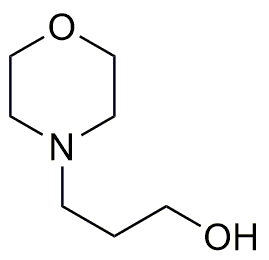4-(3-Hydroxypropyl)morpholine is widely utilized in research focused on:
- Pharmaceutical Development: This compound serves as a building block in the synthesis of various pharmaceuticals, particularly in the development of drugs targeting neurological disorders due to its ability to cross the blood-brain barrier.
- Cosmetic Formulations: It is used in the formulation of skin care products, acting as a moisturizing agent that enhances skin hydration and improves texture, making it a popular choice among cosmetic chemists.
- Polymer Chemistry: The compound is employed in the production of specialty polymers, providing unique properties such as flexibility and durability, which are essential in industries like automotive and packaging.
- Surfactant Applications: It functions as a surfactant in cleaning products, improving the wetting and emulsifying properties, which enhances the effectiveness of detergents and cleaners.
- Biochemical Research: Researchers utilize it as a reagent in various biochemical assays, particularly in studies involving enzyme activity and protein interactions, due to its stability and reactivity.
General Information
Properties
Safety and Regulations
Applications
4-(3-Hydroxypropyl)morpholine is widely utilized in research focused on:
- Pharmaceutical Development: This compound serves as a building block in the synthesis of various pharmaceuticals, particularly in the development of drugs targeting neurological disorders due to its ability to cross the blood-brain barrier.
- Cosmetic Formulations: It is used in the formulation of skin care products, acting as a moisturizing agent that enhances skin hydration and improves texture, making it a popular choice among cosmetic chemists.
- Polymer Chemistry: The compound is employed in the production of specialty polymers, providing unique properties such as flexibility and durability, which are essential in industries like automotive and packaging.
- Surfactant Applications: It functions as a surfactant in cleaning products, improving the wetting and emulsifying properties, which enhances the effectiveness of detergents and cleaners.
- Biochemical Research: Researchers utilize it as a reagent in various biochemical assays, particularly in studies involving enzyme activity and protein interactions, due to its stability and reactivity.
Documents
Safety Data Sheets (SDS)
The SDS provides comprehensive safety information on handling, storage, and disposal of the product.
Product Specification (PS)
The PS provides a comprehensive breakdown of the product’s properties, including chemical composition, physical state, purity, and storage requirements. It also details acceptable quality ranges and the product's intended applications.
Certificates of Analysis (COA)
Search for Certificates of Analysis (COA) by entering the products Lot Number. Lot and Batch Numbers can be found on a product’s label following the words ‘Lot’ or ‘Batch’.
Numéro de catalogue
Numéro de lot/série
Certificates Of Origin (COO)
This COO confirms the country where the product was manufactured, and also details the materials and components used in it and whether it is derived from natural, synthetic, or other specific sources. This certificate may be required for customs, trade, and regulatory compliance.
Numéro de catalogue
Numéro de lot/série
Safety Data Sheets (SDS)
The SDS provides comprehensive safety information on handling, storage, and disposal of the product.
DownloadProduct Specification (PS)
The PS provides a comprehensive breakdown of the product’s properties, including chemical composition, physical state, purity, and storage requirements. It also details acceptable quality ranges and the product's intended applications.
DownloadCertificates of Analysis (COA)
Search for Certificates of Analysis (COA) by entering the products Lot Number. Lot and Batch Numbers can be found on a product’s label following the words ‘Lot’ or ‘Batch’.
Numéro de catalogue
Numéro de lot/série
Certificates Of Origin (COO)
This COO confirms the country where the product was manufactured, and also details the materials and components used in it and whether it is derived from natural, synthetic, or other specific sources. This certificate may be required for customs, trade, and regulatory compliance.


